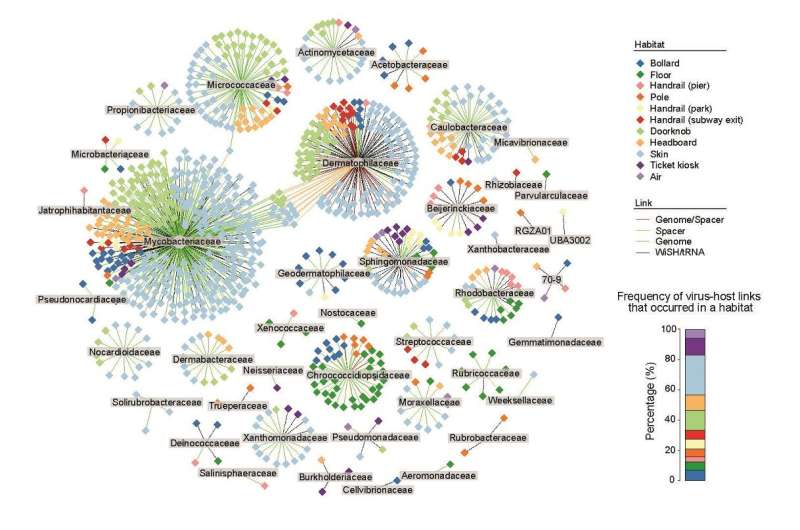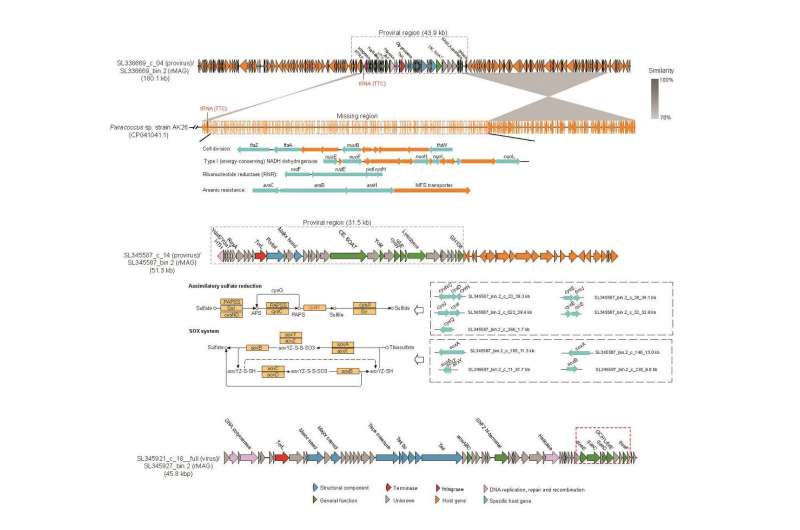This article has been reviewed according to Science X's editorial process and policies. Editors have highlighted the following attributes while ensuring the content's credibility:
fact-checked
peer-reviewed publication
trusted source
proofread
Study finds viruses can help host bacteria survive in man-made environments

Viruses in man-made environments cause public health concerns, but they are generally less studied than bacteria. A recent study led by environmental scientists from City University of Hong Kong (CityU) provided the first evidence of frequent interactions between viruses and bacteria in man-made environments. They found that viruses can potentially help host bacteria adapt and survive in nutrient-depleted man-made environments through a unique gene insertion.
The findings were published in the journal Nature Communications under the title "Highly host-linked viromes in the built environment possess habitat-dependent diversity and functions for potential virus-host coevolution."
By understanding these virus–bacteria interactions and identifying the possible spread of antibiotic resistance genes, the research team hopes its latest findings can help derive effective control strategies to minimize human exposure to harmful microorganisms.
Virus–host interactions are central to the ecology and evolution of microbial communities in diverse ecosystems. However, the immune mechanisms of infection and the virus–host interactions that occur in man-made environments, including buildings, public space, transportation and infrastructure, have been poorly understood.
"As more and more of the global population are living in urban areas, the importance of hygiene in man-made environments is growing, particularly indoor ones, as occupants inside are constantly exposed to diverse microorganisms, which have public health implications. However, most previous studies of man-made environments overlooked viruses," said Professor Patrick Lee Kwan-Hon in the School of Energy and Environment (SEE) at CityU, who led the study.
"Therefore, in our study, we comprehensively investigated viruses in man-made environments, and we identified many novel molecular mechanisms in which viruses and bacteria interact with each other. These findings are important not only for basic microbial science, but also the management of man-made environments to protect residents' health," added Professor Lee.
In the study, researchers collected 738 samples from different types of man-made environments, including public facilities and residences, in Hong Kong. They collected the samples mainly from the surfaces of handrails, bollards, floors, poles, doorknobs and skin of residents. Then they used the metagenomic sequencing technique for analysis.

The analysis resulted in many interesting discoveries. First, the data showed that viruses are integral members of microbial communities in man-made environments. Among them, bacteriophages, a kind of virus that infects and replicates within bacteria, are all over various surfaces in man-made environments. The team also identified many viruses that are distinct from those in other ecosystems.
Second, the team found evidence of viruses inserting genes that control a specific step in a metabolic pathway and even the entire metabolic pathway into bacteria hosts. This suggests that viruses could help bacteria adapt and coevolve to survive in nutrient-depleted man-made environments.
The study also found diverse and novel immune systems against viruses in bacteria, and small proteins in viruses that can evade bacteria immune systems. These results suggest that viruses and bacteria hosts frequently interact with each other in man-made environments and that they each have mechanisms to defend against each other.
They also detected antibiotic resistance genes (ARGs) in viruses on human skin and frequently touched indoor surfaces. These ARG-carrying viruses might infect bacterial hosts, and ARGs might be horizontally transferred between bacterial species. Therefore, the role played by viruses in man-made environments in the development of antibiotic resistance in bacteria is crucial and warrants further investigation.
"Our study shows that the diversity, composition, metabolic functions and lifestyle of viruses vary, depending on the conditions of each man-made environment," said Professor Lee. "Therefore, it is important to develop customized control strategies to minimize human exposure to harmful microorganisms and to better protect residents' health. Our findings can contribute to this goal by enhancing the fundamental understanding of complex virus–bacteria interactions in man-made environments."
More information: Shicong Du et al, Highly host-linked viromes in the built environment possess habitat-dependent diversity and functions for potential virus-host coevolution, Nature Communications (2023). DOI: 10.1038/s41467-023-38400-0
Journal information: Nature Communications
Provided by City University of Hong Kong




















